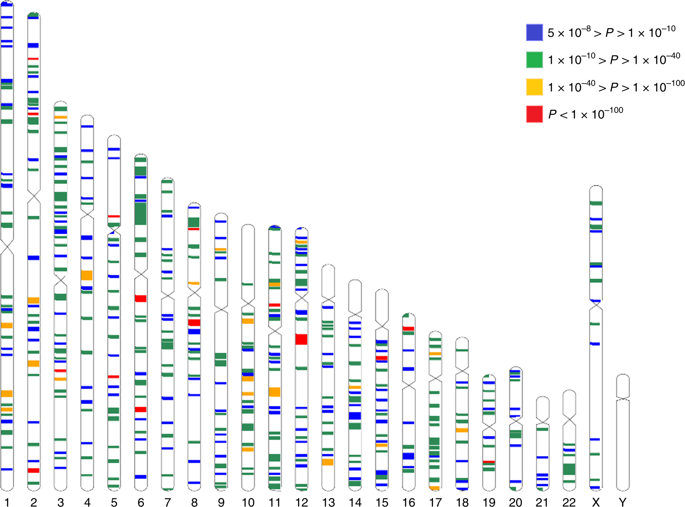当前位置:
X-MOL 学术
›
Nat. Genet.
›
论文详情
Our official English website, www.x-mol.net, welcomes your
feedback! (Note: you will need to create a separate account there.)
Meta-analysis of 542,934 subjects of European ancestry identifies new genes and mechanisms predisposing to refractive error and myopia.
Nature Genetics ( IF 31.7 ) Pub Date : 2020-03-30 , DOI: 10.1038/s41588-020-0599-0 Pirro G Hysi 1, 2, 3 , Hélène Choquet 4 , Anthony P Khawaja 5, 6 , Robert Wojciechowski 7, 8 , Milly S Tedja 9, 10 , Jie Yin 4 , Mark J Simcoe 2 , Karina Patasova 1 , Omar A Mahroo 1, 5 , Khanh K Thai 4 , Phillippa M Cumberland 3, 11 , Ronald B Melles 12 , Virginie J M Verhoeven 9, 10, 13 , Veronique Vitart 14 , Ayellet Segre 15 , Richard A Stone 16 , Nick Wareham 6 , Alex W Hewitt 17 , David A Mackey 17, 18 , Caroline C W Klaver 9, 10, 19, 20 , Stuart MacGregor 21 , , Peng T Khaw 5 , Paul J Foster 5, 22 , , Jeremy A Guggenheim 23 , , Jugnoo S Rahi 3, 5, 11, 24 , Eric Jorgenson 4 , Christopher J Hammond 1, 2
Nature Genetics ( IF 31.7 ) Pub Date : 2020-03-30 , DOI: 10.1038/s41588-020-0599-0 Pirro G Hysi 1, 2, 3 , Hélène Choquet 4 , Anthony P Khawaja 5, 6 , Robert Wojciechowski 7, 8 , Milly S Tedja 9, 10 , Jie Yin 4 , Mark J Simcoe 2 , Karina Patasova 1 , Omar A Mahroo 1, 5 , Khanh K Thai 4 , Phillippa M Cumberland 3, 11 , Ronald B Melles 12 , Virginie J M Verhoeven 9, 10, 13 , Veronique Vitart 14 , Ayellet Segre 15 , Richard A Stone 16 , Nick Wareham 6 , Alex W Hewitt 17 , David A Mackey 17, 18 , Caroline C W Klaver 9, 10, 19, 20 , Stuart MacGregor 21 , , Peng T Khaw 5 , Paul J Foster 5, 22 , , Jeremy A Guggenheim 23 , , Jugnoo S Rahi 3, 5, 11, 24 , Eric Jorgenson 4 , Christopher J Hammond 1, 2
Affiliation

|
Refractive errors, in particular myopia, are a leading cause of morbidity and disability worldwide. Genetic investigation can improve understanding of the molecular mechanisms that underlie abnormal eye development and impaired vision. We conducted a meta-analysis of genome-wide association studies (GWAS) that involved 542,934 European participants and identified 336 novel genetic loci associated with refractive error. Collectively, all associated genetic variants explain 18.4% of heritability and improve the accuracy of myopia prediction (area under the curve (AUC) = 0.75). Our results suggest that refractive error is genetically heterogeneous, driven by genes that participate in the development of every anatomical component of the eye. In addition, our analyses suggest that genetic factors controlling circadian rhythm and pigmentation are also involved in the development of myopia and refractive error. These results may enable the prediction of refractive error and the development of personalized myopia prevention strategies in the future.
中文翻译:

对 542,934 名欧洲血统受试者的荟萃分析确定了易患屈光不正和近视的新基因和机制。
屈光不正,尤其是近视,是全世界发病率和残疾的主要原因。基因研究可以提高对导致眼睛发育异常和视力受损的分子机制的理解。我们对涉及 542,934 名欧洲参与者的全基因组关联研究 (GWAS) 进行了荟萃分析,并确定了 336 个与屈光不正相关的新基因位点。总的来说,所有相关的遗传变异解释了 18.4% 的遗传力并提高了近视预测的准确性(曲线下面积 (AUC) = 0.75)。我们的研究结果表明,屈光不正具有遗传异质性,由参与眼睛每个解剖组成部分发育的基因驱动。此外,我们的分析表明,控制昼夜节律和色素沉着的遗传因素也与近视和屈光不正的发展有关。这些结果可能有助于预测屈光不正和未来制定个性化的近视预防策略。
更新日期:2020-04-24
中文翻译:

对 542,934 名欧洲血统受试者的荟萃分析确定了易患屈光不正和近视的新基因和机制。
屈光不正,尤其是近视,是全世界发病率和残疾的主要原因。基因研究可以提高对导致眼睛发育异常和视力受损的分子机制的理解。我们对涉及 542,934 名欧洲参与者的全基因组关联研究 (GWAS) 进行了荟萃分析,并确定了 336 个与屈光不正相关的新基因位点。总的来说,所有相关的遗传变异解释了 18.4% 的遗传力并提高了近视预测的准确性(曲线下面积 (AUC) = 0.75)。我们的研究结果表明,屈光不正具有遗传异质性,由参与眼睛每个解剖组成部分发育的基因驱动。此外,我们的分析表明,控制昼夜节律和色素沉着的遗传因素也与近视和屈光不正的发展有关。这些结果可能有助于预测屈光不正和未来制定个性化的近视预防策略。











































 京公网安备 11010802027423号
京公网安备 11010802027423号